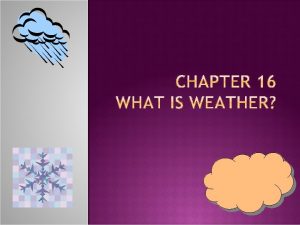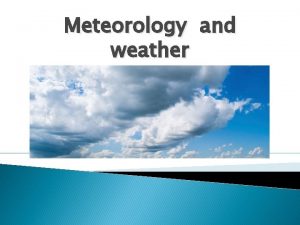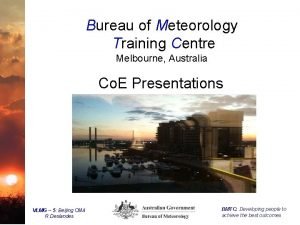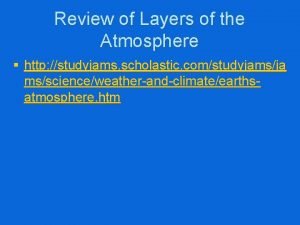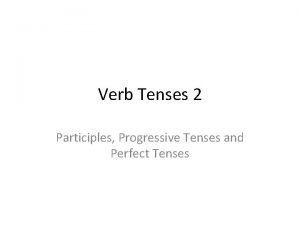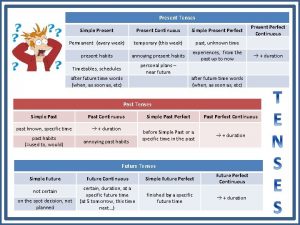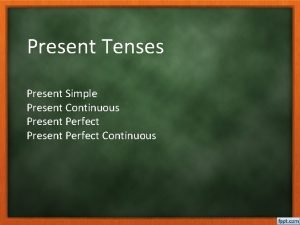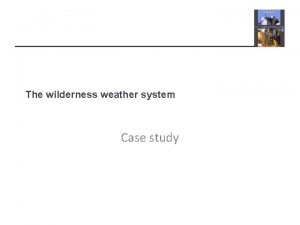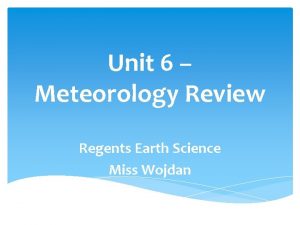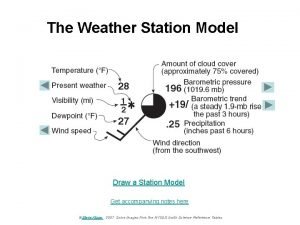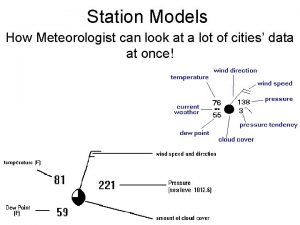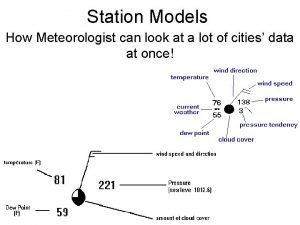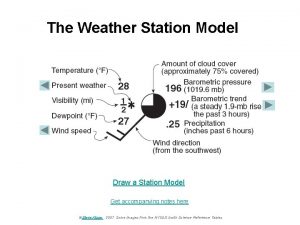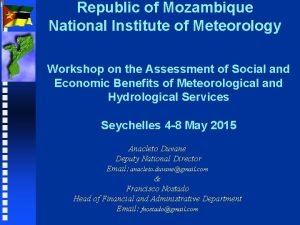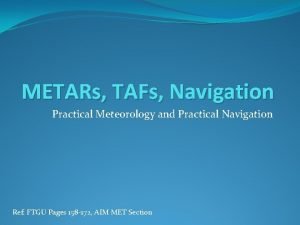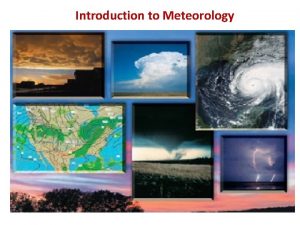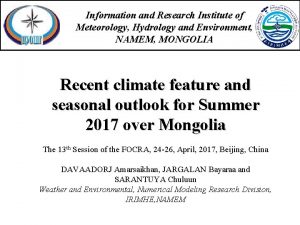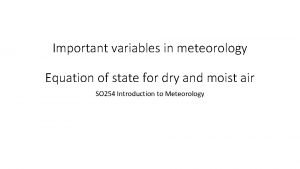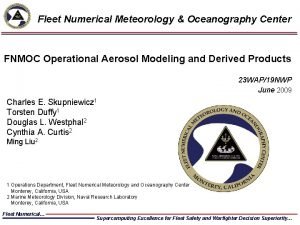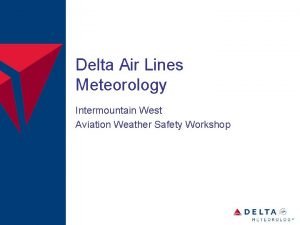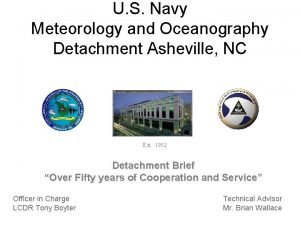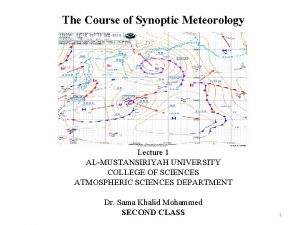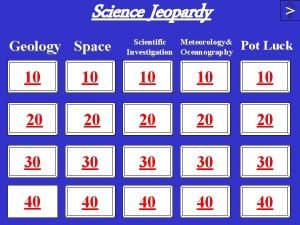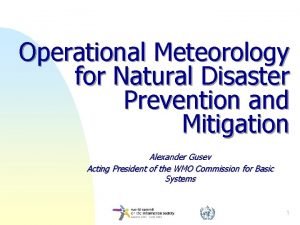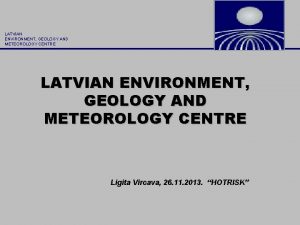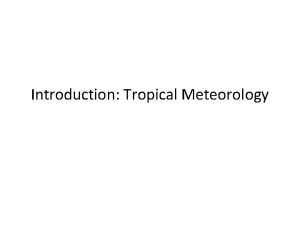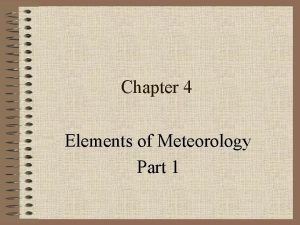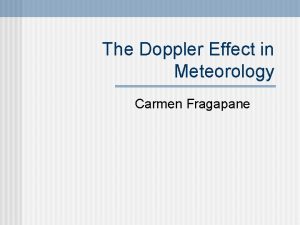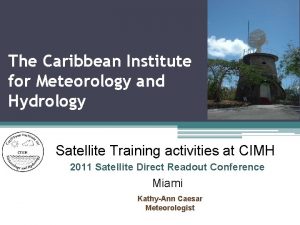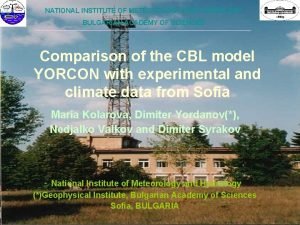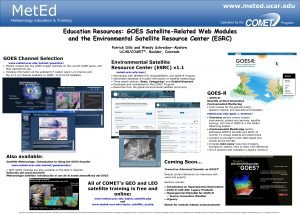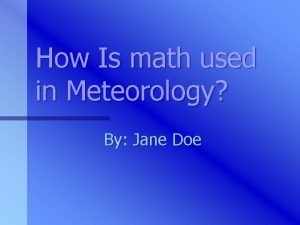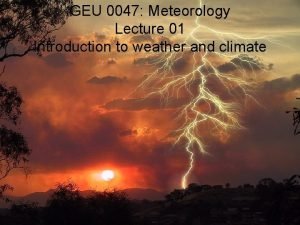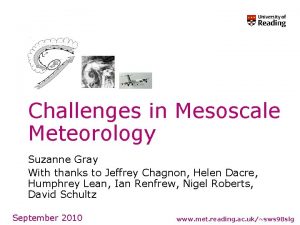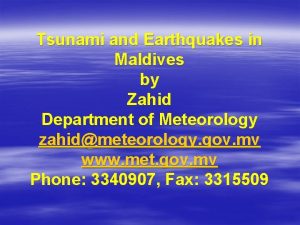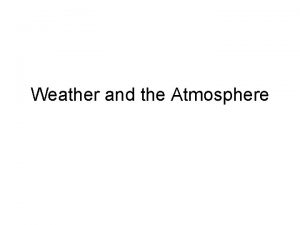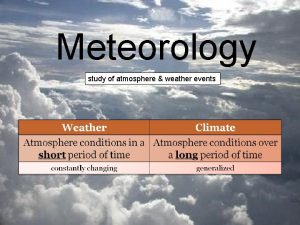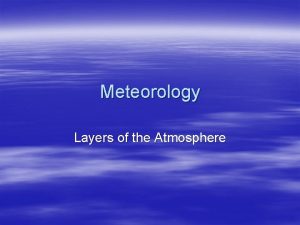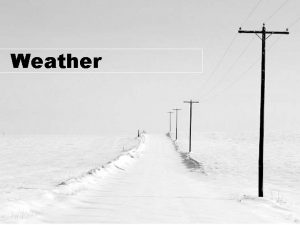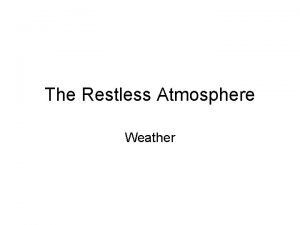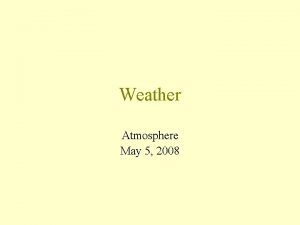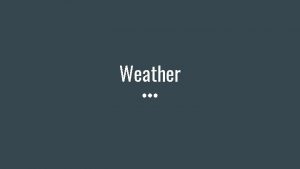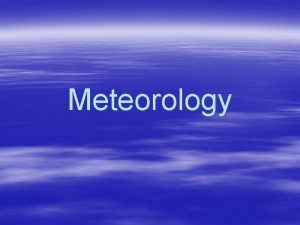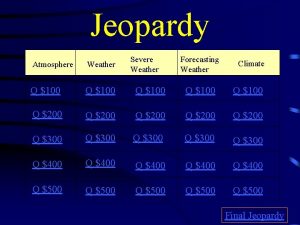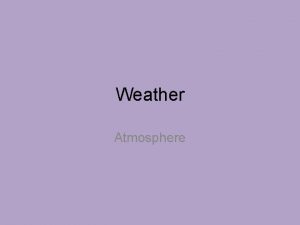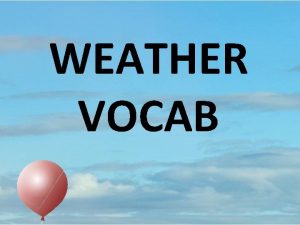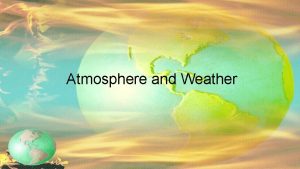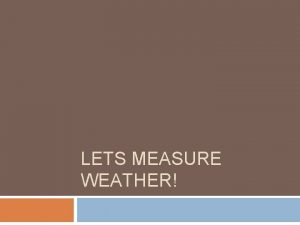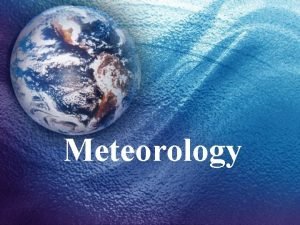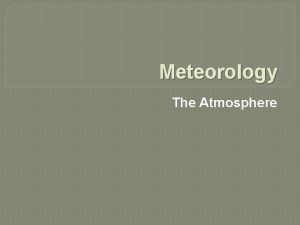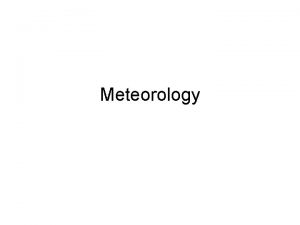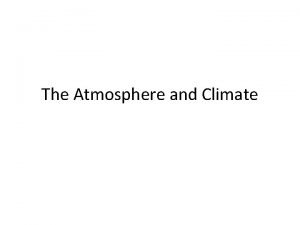Meteorology meteorology study of atmosphere 1 weather present


















































- Slides: 50

Meteorology meteorology = study of atmosphere 1. weather = present state of atmosphere and describes current conditions a. caused by interaction of air, water, and solar energy b. variation can take place over minutes, hours, days, weeks, or months 2. climate = average of all weather conditions of area over long period of time

energy balance on Earth: 1. Earth radiates back to space about as much energy as it receives over a year’s time 2. sun feels hotter in afternoon due to rays striking Earth more directly 3. morning and evening rays strike Earth at lower angle and energy is spread over larger area 4. solar radiation reaching poles is less intense 5. tropics and other places maintain fairly constant average temperatures due to heat being redistributed around the world 6. continual motion of air and water reallocate heat energy among surface, oceans, and atmosphere

air mass = large body of air that has same properties as region over which it develops 1. source region = area over which an air mass forms 2. originate in parts of world where winds are light 3. can be several thousand kilometers in diameter and several kilometers deep 4. temperature determined by whether it comes from tropics or polar regions 5. humidity determined by whether it comes from land or sea

6. classified according to source region a. “c” = continental (dry) b. “m” = maritime (moist) c. “P” = polar (cool) high latitudes d. “T” = tropical (warm) low latitudes e. “A” = arctic 7. weather maps use two symbols together to describe temperature and humidity Ex: m. T = warm moist

8. five major types affect weather in United States a. m. T = maritime tropical 1) forms over warm waters of Gulf of Mexico and tropical North Atlantic Ocean 2) holds warm, moist air 3) comes into U. S. from Pacific and Atlantic oceans and Gulf of Mexico 4) summer = hot, humid weather, thunderstorms, hurricanes 5) winter = mild, often cloudy weather

b. m. P = maritime polar 1) come from cold ocean water (North Pacific Ocean) 2) holds cold, moist air 3) forms over Pacific Ocean in winter and summer as well as North Atlantic in summer 4) winter = rain and snow to Pacific Coast; summer = cool, foggy weather 5) maritime polar Atlantic = form over North Atlantic Ocean a) winter = cold, cloudy weather and precipitation b) summer = cool weather with low clouds and fog 6) can produce heavy snow and cold temperatures

c. c. T = continental tropical 1) form over the deserts of south-western U. S. and Mexico 2) flow over North America only in the summer 3) brings in clear, dry and very hot weather 4) produces a warm, dry climate d. c. P = continental polar (Canadian) 1) forms over interior of Canada and Alaska covered by ice and snow 2) move southeastward across Canada and into northern U. S. A. 3) brings in cold, dry air (summer) 4) during winter can produce extremely cold temperatures

e. A = arctic air 1) basically same as continental polar air mass, but much colder 2) brings most frigid outbreaks of winter 3) usually associated with very high pressure systems 4) develops over latitudes above 60 o. N in ice and snow covered regions of Siberia and Arctic Basin 5) during winter this region receives almost no solar radiation but continues to radiate heat out to space causing it to be very cold area

9. air mass modification = occurs when air mass starts to gain some of characteristics of new surface beneath it a. usually an exchange of heat or moisture with surface over which air mass travels b. modified some as move away from source region c. eventually modified to have same characteristics as new surface it moves over

WEATHER SYSTEMS Factors responsible for air movement: 1. Earth’s surface is curved rather than flat a. causes uneven heating in areas around world b. equator heated more than any other place causing air to have low density and rise c. poles are cooler so air is more dense and sinks and moves along the surface

2. Coriolis effect = apparent deflection of objects (air) moving across earth’s surface a. caused by an apparent force that results from earth’s eastward rotation (to the right) b. objects in Northern Hemisphere moving south would be turned west (deflected right) air movement = northeast to southwest c. objects in Southern Hemisphere are deflected to the left air movement = southeast to northwest d. combines with global wind systems that transport colder air to warmer areas and warmer air to colder areas

3. convection cells = looping pattern of flowing air a. North and Southern hemisphere each have three b. form by air rising and sinking at various latitudes across surface

WIND SYSTEMS: Victor Starr (American meteorologist) = designed model of major wind systems which suggested that major wind patterns were controlled by combination of unequal heating and Earth’s rotation winds = formed by the movement of air from one place to another 1. caused by differences in temperature and pressure 2. named for direction from which they blow (flow) Global winds: 1. doldrums = windless zone at equator (0 o latitude) a. receives much of sun’s energy b. warm air rises producing low pressure area c. cooler high pressure air warmed so rapidly that winds formed don’t reach area d. any winds that form are very weak

2. trade winds = winds that move from north or south toward equator a. occur usually at 30 o. N and 30 o. S latitudes 1) air sink, warms, and moves toward equator in westerly direction 2) when air reaches equator, it will rise again and move back toward 30 o latitude where it sinks and process starts over 3) Northeast trade winds = in Northern Hemisphere, blow from NE to SW 4) Southeast trade winds = in Southern Hemisphere, blow from SE to NW c. 30 o. N and S latitudes are also called horse latitudes 1) at times winds become calm stranding ships for days or weeks 2) those carrying horses began throwing them overboard when food supply ran out d. convergence: 1) wind from both hemispheres move together from two different directions 2) air converges, is forced upward, and creates area of low pressure 3) ITCZ (intertropical convergenence zone) = large area near equator where convergence occurs

3. prevailing westerlies a. located between 30 o to 60 o latitudes (north and south) 1) circulation pattern opposite of trade winds 2) surface winds move toward poles in generally easterly direction b. responsible for movement of weather across United States and Canada c. Northern Hemisphere = blow SW to NE Southern Hemisphere = blow NW to SE d. are often particularly strong winds

4. polar easterlies = cold, dense, horizontal air currents a. occurs at the 90 o latitudes forcing air up at 60 o latitudes b. have weak winds but provide large amounts of energy to westerlies 1) strongest where flow off Antarctica 2) polar front = form where easterlies meet westerlies producing stormy area 3) characterized by cold air c. causes changes in weather across United States d. subpolar lows = belt of low air pressure at about 60 o. N and 60 o. S latitude e. Northern Hemisphere = blow NE to SW Southern Hemisphere= blow SE to NW

jet streams = narrow belts of fast, high altitude, westerly winds 1. located in upper troposphere and lower stratosphere 2. strong, high speed, high pressure air 3. flow from west to east 4. two in each hemisphere a. polar jet stream 1) separates prevailing westerlies from polar easterlies (60 o latitude) 2) altitude of 10 -15 km, ~100 km wide, 2 -3 km thick 3) maximum wind speed = ~ 500 km/hr 4) winds change speed and direction 5) control path of storms and effect airline routes

b. subtropical jet stream 1) separates trade winds from prevailing westerlies (30 o latitude) 2) warm equatorial air meets cooler air of middle latitudes 3) do not change much in speed or position 5. average wind speed range = 60 km/h up to 350 km/h 6. tend to wander up and down as they flow around Earth 7. wind speed, depth, positions in latitude and altitude change from season to season or even day to day 8. large scale weather systems generally follow path of these winds

LOCAL WINDS: 1. breezes = gentle winds that extend over distances of less than 100 km 2. sea breezes = flow of air from the sea to the land a. cool, dense air from over the water flows inland forces warm air over land up b. forms 3 -4 hours after sunrise and peaks in early afternoon c. caused by the water being cooler than land during the day d. surrounding area temperature may drop by as much as 5 o. C within an hour

3. land breezes = flow of air from the land to the sea a. cool air from land flows over the warmer water and pushes warm air over sea up b. occurs at night because land loses its heat to the atmosphere while water retains its heat c. starts to form in late evening and peaks near sunrise

4. valley breeze = flow of air up the slopes of mountains a. occurs during the day b. caused by warm air from valleys moving up slope 5. mountain breeze = flow of air from mountain peaks to valley a. occurs during the night b. mountains cool more quickly 6. monsoon = seasonal winds a. part of the year it blows from the land to the ocean → winter usually b. part of the year it blows from the ocean to the land → summer usually c. summer monsoon causes rainy season with warm temperatures and huge amounts of rain

front = boundary formed between two air masses that have collided 1. area where temperatures and humidities change 2. greater the difference between air masses, greater the change in weather 3. can stretch over thousands of km across Earth’s surface 4. interaction between colliding air masses can cause dramatic changes in weather

Four Types of Fronts 1. warm front = warm air is pushing ahead and displacing colder air a. lighter warm air slides over heavier cold air b. presence of high cirrus clouds c. stratus clouds form as front continues to move into an area d. may produce precipitation over a large area (rain, snow, sleet, or freezing rain) e. weather map symbol =

2. cold front = cold air is advancing and displacing warmer air a. heavier, cold air is shoving under warm air, pushing it upward rapidly b. cumulus and cumulonimbus clouds form c. produces rain and thunderstorms that can be violent d. squall line = long line of heavy thunderstorms just ahead of front e. fair, cool weather usually follows f. weather map symbol =

3. stationary front = two air masses collide and neither can advance the other a. front does not move; boundary between air masses stalls b. pressure differences cause warm front or cold front to stop moving forward c. usually remains for several days d. widespread clouds can form on both sides of frontal boundary e. light winds and precipitation may occur across entire frontal region f. weather map symbol =

4. occluded fronts = created when cold, warm, and cool air come in conflict a. two cooler air masses merge, forcing warm air between them to rise b. often called occlusions c. two types: 1) cold occlusion = cold air is shoving under cool air at Earth’s surface 2) warm occlusion = cool air rises over cold air at the surface d. usually see strong winds and heavy precipitation e. weather map symbol =

5. polar front = boundary where cold polar air meets warmer air of middle latitudes a. circle between 40 o and 60 o latitudes N and S b. winter - average position is across middle of U. S. c. summer - north of Great Lakes d. wave = bend formed in a cold or stationary front

Pressure Systems: high pressure = form when air is cooled 1. air molecules more densely packed 2. result of cold, dense air that is sinking and spreads outward from centers when reach Earth 3. warming of air decreases its relative humidity and water vapor is evaporated 4. Northern Hemisphere → rotates clockwise; Southern Hemisphere counterclockwise 5. usually means clear weather 6. weather map symbol = H

low pressure = form when air is warmed and rises 1. molecules farther apart → less dense → rises 2. rising air must be replaced by air from outside system, so net flow is toward center and upward 3. forms along fronts where warm air meets cold air 4. Northern hemisphere counterclockwise; Southern hemisphere clockwise 5. cause most of weather changes across United States 6. associated with clouds and precipitation 7. weather map symbol = L

8. wave cyclone = specific type of low pressure system a. main producers of inclement weather in middle latitudes b. usually begins along stationary front c. part of front moves south as cold front and another part moves north as warm front d. sets up counterclockwise circulation * Air moves from an area of high pressure to one of low pressure.

GATHERING WEATHER DATA: thermometer = used to measure temperature 1. bimetal thermometer = bar made of two strips of different types of metals a. curve when heat b. straighten when cooled 2. thermograph = measures temperature change by recording movement of bar 3. electrical thermometer a. as temperature rises, electric current flow increases b. current flow translated into temperature readings

barometer = instrument measures atmospheric pressure 1. mercurial barometer = uses mercury to determine atmospheric pressure a. pressure presses on liquid Hg in well at base b. squeezes Hg up to certain height in tube c. height varies with pressure d. expressed by how high Hg rises in tube e. standard atmospheric pressure = 760 mm 1) indicates average atmospheric pressure at sea level 2) 760 mm or 29. 92 inches of Hg = one atmosphere f. millibars(mb)) - used on weather maps 1 mb = 0. 001 standard atmospheric pressure

2. aneroid barometer = works without liquid a. most common type used today b. seal metal container from which air has been removed 1) pressure decreases → sides bulge out 2) pressure increases → sides bend inward c. shown by pointer on a scale d. usually marked in mm (inches of Hg) or mb e. altimeter = barometer used to measure altitude above sea level 1) lowered pressure reading interpreted as increased altitude 2) must be corrected for local weather conditions to be accurate

anemometer = used to measure wind speed 1. expressed as meters/second, miles/hour, or knots 2. one knot = 1850 m/s wind vane = used to determine the direction of the wind on Earth’s surface * points into the wind

hygrometers = used to measure relative humidity 1. psychrometer = works on principle that evaporation causes cooling a. wet bulb thermometer has a water soaked wick wrapped around its bulb b. other is a dry bulb thermometer c. wet bulb usually shows a lower temperature d. readings give signs of how dry the air is e. difference between wet bulb and dry bulb is used to determine RH by using a chart f. when both thermometers read the same the air is saturated

2. hair hygrometer = based on principle that human hair stretches when it is humid a. one end of a bundle of hair is fixed while the other is attached to pointer b. when air is humid → stretches; when air is dry → shrinks back

Measuring Precipitation: 1. rain gauge = measure amount of rainfall a. measure in inches b. measure only precipitation that falls in one spot c. represents depth of water that rain would leave if it did not soak into ground, flow away, or evaporate d. types vary 1) wide mouth funnel over cylindrical container 2) funnel and small divided bucket 3) water caught in large bucket and weighed continuously

2. measuring stick = measure amount of snowfall a. snow is measure by both depth of accumulation and water content b. measured in inches and tenths of an inch c. on average, 10 inches of snow equals 1 inch of rain d. dry snows are deeper than equal weights of wet snow

Automated Surface Observing System (ASOS) = collects multiple data at regular intervals 1. ceilometer = measures height of cloud layers and estimates amount of sky covered by clouds 2. continuously record air pressure, temperature, wind speed and direction, runway visibility, cloud ceiling, and precipitation intensity 3. many units being used at major airports

Upper Level Data: 1. radiosonde = balloon borne package of sensors for measuring at high altitudes a. measure temperature, air pressure, and humidity b. readings sent back by radio signal to ground station that tracks movement of balloon c. can determine wind speed and direction by tracking how fast and in what direction balloon is moving

2. weather radar = used to locate areas of rain a. waves are reflected from precipitation particles b. screen shows location and shape of precipitation areas c. also gives a rough idea of how heavy precipitation is

3. Doppler radar = used to determine movement of weather system a. provides good estimates of wind speeds in precipitation areas b. show echoes with more detail c. can also show wind direction d. echoes and winds show up on color screen 1) different echo strengths or wind speeds show up as different colors 2) makes it easier to spot strong thunderstorms and even tornadoes

4. weather satellites = observes weather that is missing by computer models and local weather a. observations track clouds but not necessarily precipitation b. provides continuous pictures of clouds c. make it possible to track lows, hurricanes, and thunderstorms d. can see nearly half of Earth’s surface e. every 30 minutes its television cameras take infrared as well as visible pictures

WEAHTER ANALYSIS/ FORECASTING forecast = prediction of future weather conditions - most are made for periods of a few hours up to 5 days meteorologist = person who studies weather 1. make measurements of temperature, air pressure, winds, humidity, and precipitation 2. gather data using radar, computers, and instruments attached to balloons 3. interpret information from local weather observers, balloons, satellites, and weather stations around world

weather map = collection of weather data from many collecting stations surface weather map = essential in following rapidly changing weather or in compensating for poor computer model forecasts 1. data is taken hourly at stations all over the world 2. United States has about 700 National Weather Service stations 3. official U. S. weather maps are made every 3 hours (made at the National Meteorological Center in Camp Springs, Maryland)

station model = symbol that describes local weather of collecting station 1. where possible direct readings are given 2. in other cases, codes are used 3. models and codes are determined by World Meteorological Organization 4. show various measurements a. wind direction and speed 1) shown by a line attached to circle 2) direction line points is from which wind is blowing 3) small lines at end of the line are used to indicated wind speed b. cloud cover shown by circle c. other data includes atmospheric pressure, temperature, dew point, types of precipitation, types of clouds, and change in barometric pressure

isopleths = lines that connect points of equal or constant values 1. can represent different weather variables 2. isotherm = lines that connect locations with same temperature on weather map - number on end of line indicates temperature at all points along line

3. isobars = lines that connect locations with the same air pressure on a weather map a. number at end of line represents air pressure at each location on line b. can be given in millibars or inches of mercury c. indicates the locations of highs or lows d. if close together → great pressure difference over small area → strong winds e. if spread apart → less difference → gentle winds

TYPES OF FORECASTS SHORT-TERM: 1. daily = predict weather conditions for 48 hour period 2. digital forecasting = relies on numerical data from computer calculations a. main method used by modern meteorologists b. highly dependent on density of data available (more data, more accurate forecast) 3. most accurate and detailed forecasts; can be made for 3 to 5 days 4. accuracy decreases with each additional day

LONG-TERM: 1. long-range = cover monthly and seasonal outlooks 2. extended = up to 6 to 10 days 3. analog forecasts = compares current weather patterns to patterns that took place in past a. uses assumption that weather systems behave in similar fashion b. also look for patterns that are analogous to current patterns c. to be accurate past event must be similar through all levels of atmosphere and over large area d. used for monthly or seasonal forecasts 4. computer model = copy of atmosphere in computer a. contains data on wind, temperature, pressure, humidity, clouds, and precipitation b. can predict future weather patterns 5. now better than human forecasters at predicting movements and strengths of highs and lows
 High thin white feathery clouds called
High thin white feathery clouds called The study of weather is
The study of weather is Bureau of meteorology
Bureau of meteorology Studyjams heat flow
Studyjams heat flow Station model
Station model How many seasons are there
How many seasons are there Poem on seasons
Poem on seasons It's cloudy and windy
It's cloudy and windy Weather and whether
Weather and whether Heavy weather by weather report
Heavy weather by weather report Capital weather gang weather wall
Capital weather gang weather wall I write a letter now past continuous tense
I write a letter now past continuous tense Present simple present continuous present perfect
Present simple present continuous present perfect Present perfect schema
Present perfect schema Relative clause noredink
Relative clause noredink Wish in present
Wish in present Present simple present continuous present perfect
Present simple present continuous present perfect Present simple present continuous and present perfect
Present simple present continuous and present perfect A wilderness weather station case study
A wilderness weather station case study Wilderness weather station case study
Wilderness weather station case study Which map shows the most probable areas of precipitation
Which map shows the most probable areas of precipitation Station model knots
Station model knots Station model
Station model Barometric pressure on a station model
Barometric pressure on a station model Weather station symbols
Weather station symbols Cisk meteorology
Cisk meteorology National institute of meteorology
National institute of meteorology Penn state meteo
Penn state meteo Metars and tafs
Metars and tafs Definition of meteorology
Definition of meteorology Meteorology hydrology and water management
Meteorology hydrology and water management Meteorology equations
Meteorology equations Fnmoc meteorology products
Fnmoc meteorology products Delta meteorology
Delta meteorology Cin meteorology
Cin meteorology Us navy meteorology
Us navy meteorology Synoptic meteorology definition
Synoptic meteorology definition Meteorology jeopardy
Meteorology jeopardy Meteorology
Meteorology Latvian environment, geology and meteorology centre
Latvian environment, geology and meteorology centre Introduction to tropical meteorology
Introduction to tropical meteorology Elements of meteorology
Elements of meteorology Types of visibility in meteorology
Types of visibility in meteorology Doppler effect in meteorology
Doppler effect in meteorology Caribbean institute for meteorology and hydrology
Caribbean institute for meteorology and hydrology Yorcon
Yorcon Www.meted
Www.meted Math in meteorology
Math in meteorology Meteorology lecture
Meteorology lecture Meteorology
Meteorology Maldives earthquake
Maldives earthquake
